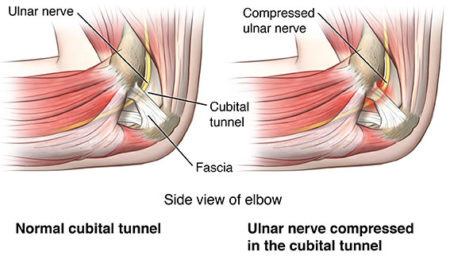 Midtown Manhattan
36 W 44th St Ste 1416 New York, NY 10036
Midtown Manhattan
36 W 44th St Ste 1416 New York, NY 10036
- (212) 621-7746
- text us
- BOOK ONLINE Call for Same Day Appointments
 Midtown Manhattan
36 W 44th St Ste 1416 New York, NY 10036
Midtown Manhattan
36 W 44th St Ste 1416 New York, NY 10036
Like its counterpart that strikes your wrists, carpal tunnel syndrome, cubital tunnel syndrome hits your elbows. Cubital tunnel syndrome treatment usually resolves itself with rest when it’s diagnosed early. Treatment for cubital tunnel syndrome relies on a wide range of modalities to help you avoid further complications. Come to our sports injury and pain management clinic to get your elbow pain evaluation and treatment. Meet our elbow doctor Febin Melepura M.D. to get the pain relief you need in the safe, reassuring hands of the best elbow specialists in NYC.

While cubital tunnel syndrome and radial tunnel syndrome aren’t as widely known as carpal tunnel syndrome, that doesn’t mean that they’re any less harmful. And these two conditions are often mistaken for their more well-known cousin. Like carpal tunnel syndrome, cubital tunnel syndrome also causes:
Increased pressure is the most common cause of these conditions. Your bone or connective tissue may be putting pressure on a nerve in your wrist. This is called nerve compression. Most cases of cubital tunnel syndrome or radial tunnel syndrome react well to conservative treatment when prescribed by your sports medicine and pain management doctor. However, if your case is more severe, surgery may be necessary to reduce the pressure on your nerve.
Cubital tunnel syndrome is also called ulnar neuropathy. Your ulnar nerve is actually pretty close to the surface of your skin and is located around the infamous “funny bone” in your elbow. You have an increased risk of the cubital syndrome if you:
Cubital tunnel syndrome can also be caused by:
Any activity that puts extra pressure on your ulnar nerve can potentially result in this condition. Catching early symptoms can save you pain and trouble down the road. If you’re experiencing any of the following symptoms, you should contact your physician immediately:
If your condition is more advanced, your symptoms are usually more serious. Here are a few things to look out for:
If your case has advanced to any of these symptoms, it may be possible for your doctor to diagnose you with just a simple physical exam. However, he may recommend a nerve conduction study or electromyography. Electromyography is a test that gauges the health of your muscles and nerve cells with the use of electrodes. This helps identify your problem area and determine the severity of the compression.
Doctor Febin Melepura and staff were very accommodating and informative. I have been dealing with pain for months and after seeing him I really feel like I have the tools and support to get better.
Kate KesselmanThe amount of pressure on your nerve affects which treatment for cubital tunnel syndrome is your best option. If the pressure on your ulnar nerve is minimal, more conservative methods of treatment for cubital tunnel syndrome are more beneficial. Mild cases, typically respond well to physical therapies such as:
More severe cases require surgical treatment for cubital tunnel syndrome. But don’t let this upset you; well over half of all cases are resolved by surgery. These procedures are designed to relieve pressure on your ulnar nerve. Surgical procedures include:
Cubital tunnel syndrome treatment has a high success rate. If you do require surgery, your recovery is going to involve restrictions to movement and lifting. Rehab and physical therapy as directed by your pain expert has to be a vital part of your recovery. But a full and complete recovery can take several months.
Pay attention to your body. Catching your condition early increases your chances for success with less invasive cubital tunnel syndrome treatments, which spares you from the lengthy recovery associated with surgery. Your case, however, is unique. Your team of sports medicine doctors is ready to help you figure out the best possible treatment for cubital tunnel syndrome for your individual needs.
Do you have any questions about the cubital tunnel syndrome treatment? Would you like to schedule an appointment with the best-rated elbow doctor Febin Melepura MD of sports injury clinic NYC? Please contact our office for a consultation with the top pain relief specialist in Midtown Manhattan.

Febin Melepura, MD is a top rated, best in class interventional pain management doctor. He is a nationally recognized pain relief specialist and is among the top pain care doctors in New York City and the country. He is an award winning expert and contributor to a prominent media outlets.
Dr. Febin Melepura has been recognized for his thoughtful, thorough, modern approach to treating chronic pain and, among other accolades, has been named a “top pain management doctor in New York”, and one of “America’s Top Doctors™” for an advanced sports injury treatments.